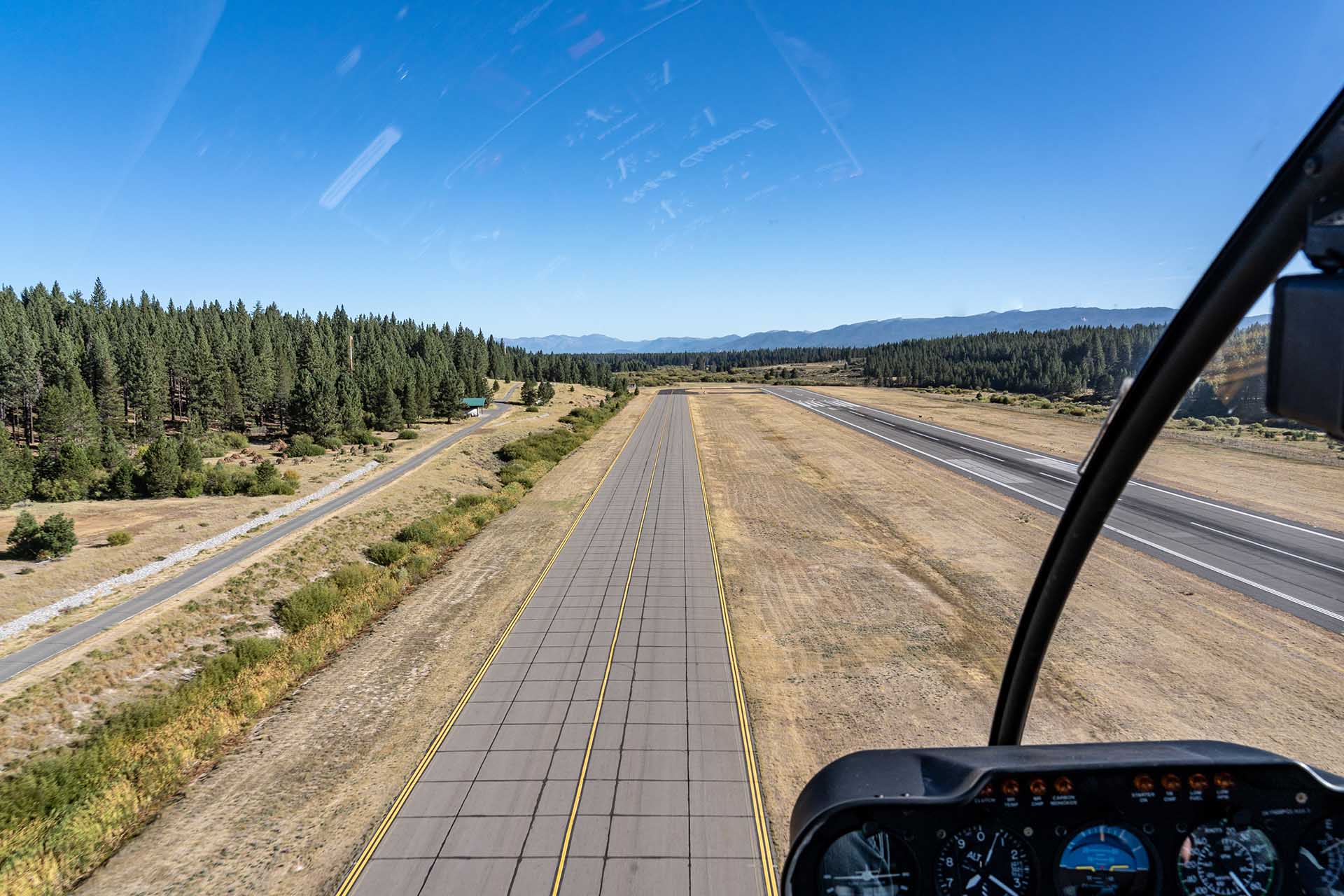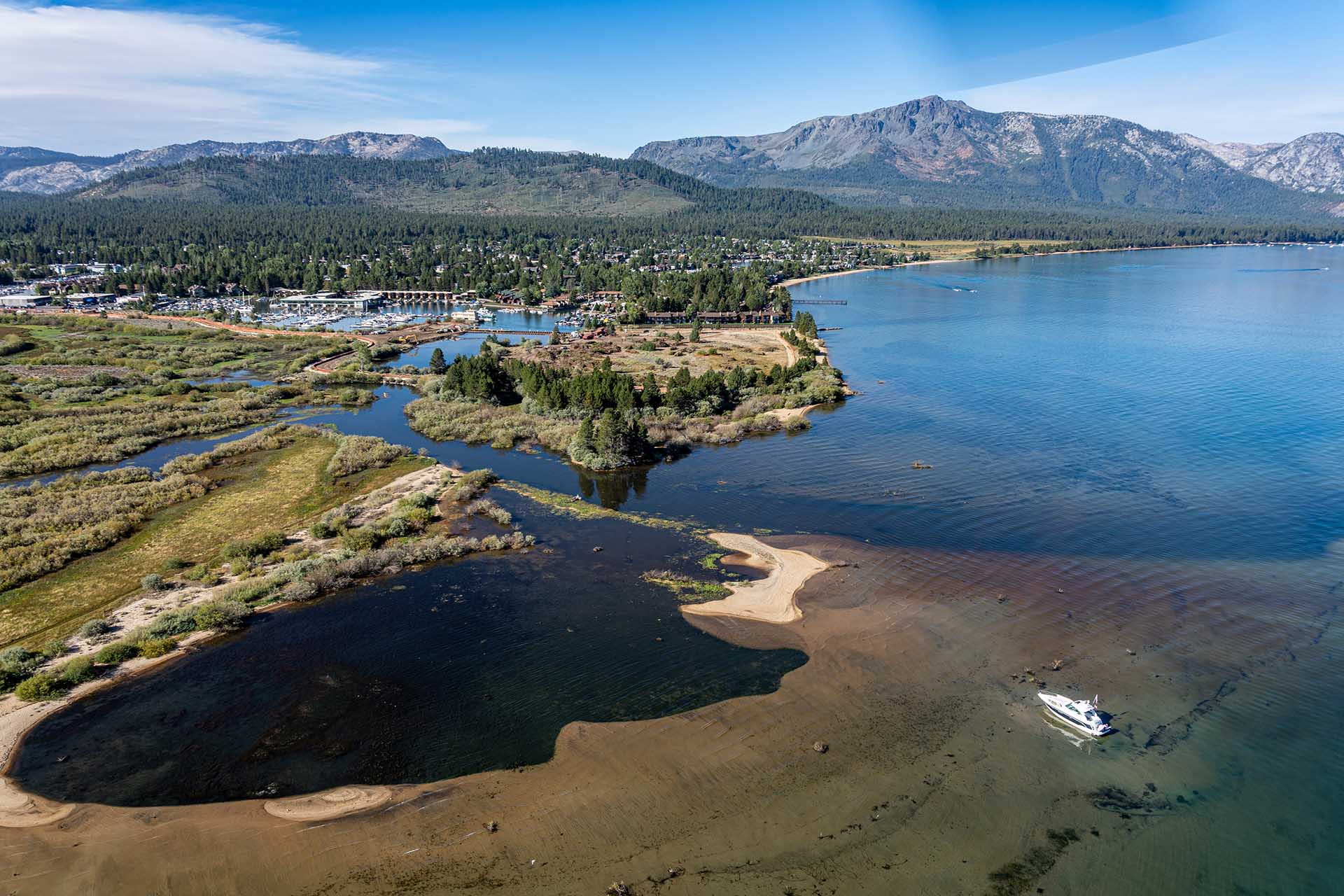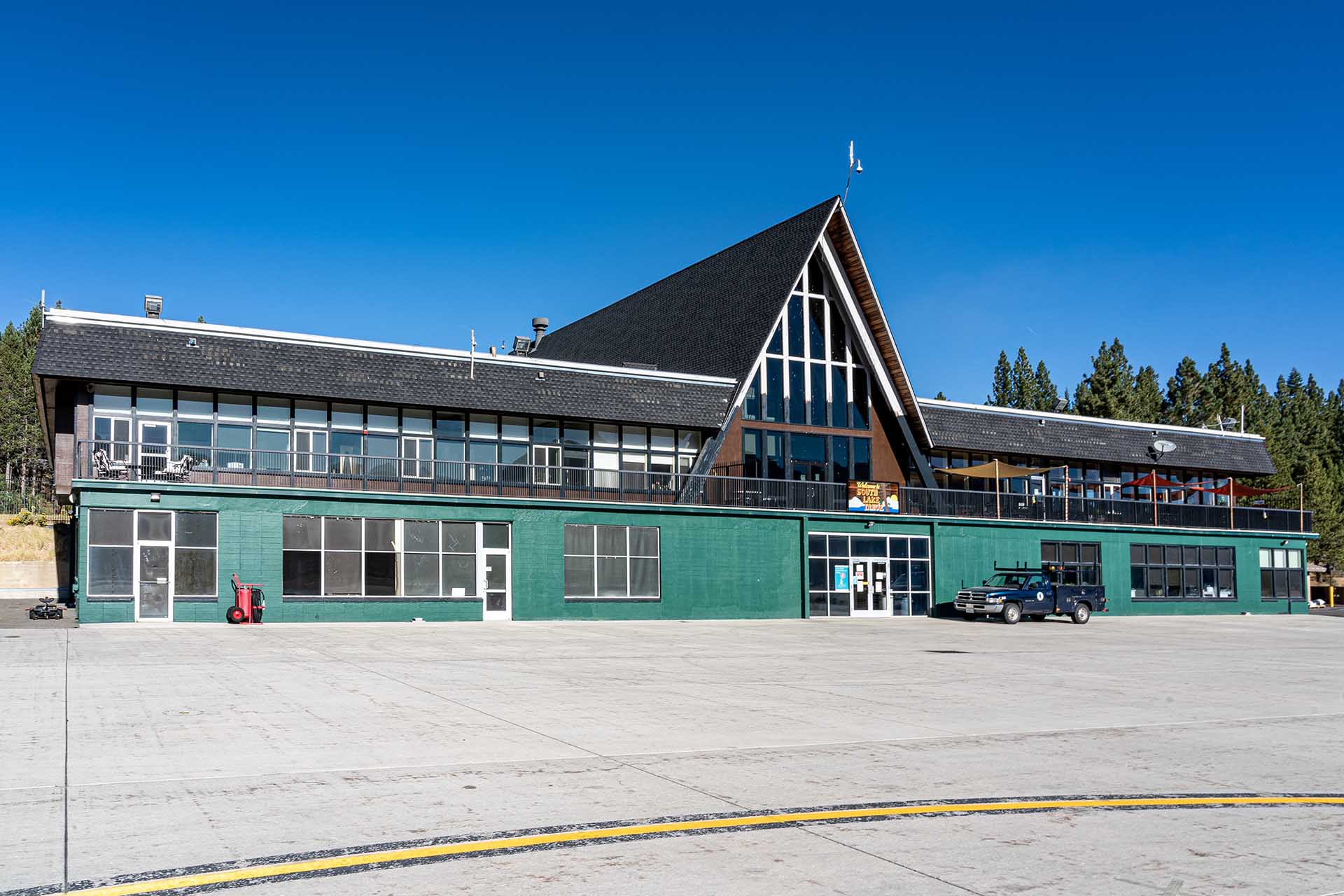Flying helicopters at high altitudes in the mountains is a notoriously difficult affair. Few companies conduct daily operations in those climates and fewer still, choose to do so in small, piston-engine helicopters. We visited with Tahoe Helicopters to learn more about what goes into providing scenic tours and flight instruction in this challenging environment, and why they prefer to operate the Robinson R44.
Not many helicopter companies operate the Robinson R44 in high altitude environments. Aircraft performance decreases drastically from sea level to the higher elevations of America’s mountain regions, creating additional risks to the already complicated task of flying. It takes specific helicopter performance capabilities, a highly specialized skill set, and the proper weather conditions to ensure a safe and successful flight at these altitudes.
Scenic flights over ‘The Jewel of the Sierras’
Tahoe Helicopters, a scenic tour and flight instruction company located high in the Sierra Nevada mountain range, does just that. Departing from the Lake Tahoe Airport, they offer 10, 20, 30, and 45-minute tours that fly passengers over some of the most iconic features in the area. The tours out to Emerald Bay, around the South Shore, those up the eastern side of the lake to Sand Harbor and sunset tours are among the most commonly scheduled. There is also a route that showcases the many lakes and waterfalls out to the west of the Tahoe Basin. During the longest flight that Tahoe Helicopters offers, sightseers can embark on a picturesque journey that wraps around the entire lake, providing an unparalleled view of the lake’s 72 miles of shoreline.
One of the key benefits of flying an R44 for these tours is the cost-effectiveness of the aircraft. In many vacation destinations around the world, helicopter tours can easily run a few hundred dollars per seat, even for a short flight. Starting at under $100 dollars per person for a ten-minute tour of the stunning Emerald Bay; having the opportunity to see Lake Tahoe from above is now an experience that nearly anyone can enjoy. “I get told all the time that I should raise the prices. I've thought about it, but you know, we don't need to raise the prices. We’re making money and people get to go up and enjoy this, many of whom wouldn't normally get to do something like this,” explains Josh Allen, owner, and operator of Tahoe Helicopters.
In addition to scenic tours, the company also provides primary and advanced helicopter flight instruction out of the South Lake Tahoe airport. Learning to fly at a field elevation of 6,264 feet, really helps pilots become proficient in mountain flying techniques such as power management and understanding wind patterns. These skills are much more necessary, and even more pronounced when operating Robinson helicopters in this ever-changing alpine environment.

Why the R44 makes so much sense
Presently, Tahoe Helicopters operates a single Robinson R44 Raven II, a two-bladed, four-seat, piston engine helicopter. Despite its size, the R44 has great performance while also maintaining low operating costs, traits that are usually high on the list of deciding factors for many tour operators. “In looking at expanding our operations we were actually looking into something a little different, something ‘nicer.’ So we were looking at an EC120 because they're cheap enough now,” admits Allen. However, he adds that, “the R44 actually has better performance in this environment.” Quiet and economical, the R44 runs on a Lycoming IO-540 fuel-injected engine, which has improved performance at altitude and affords a higher payload capacity than other R44 models. Due to its size and powerplant, the aircraft is generally quieter than other tour helicopters of similar size like an Astar or Bell 206. An important consideration when you are surrounded by a very ‘environmentally focused’ community, plus the ‘44 only burns about half the fuel that an EC120 does.
Adding to Allen, his reasoning for choosing the R44 over another type of helicopter is that the company’s tour demographic is typically pairs of passengers. It makes more sense to fill two out of three passenger seats in the Robinson versus filling only two of the four seats in an EC120 - especially when it burns twice as much fuel. Allen acknowledges that theoretically, two pairs could be combined in the ‘120, but the probability of separate customers booking the same tour at the same time is slim. It should also be noted that three passengers sit in the back and one in front, so one of the couples would not be seated together in that configuration. Similar issues arise when comparing a Bell 206 or an Astar - the operating costs are too high, and the per-flight passenger count is too low to justify the purchase, especially this early on for the company.

Vectors from student pilot to business owner
Tahoe Helicopters opened their doors in May 2018, after many years of hard work and fortunate timing. Allen started his flying career in 2011 with Reno-Tahoe Helicopters, earning only $50/day and trading the rest of his time working for them for flight training credit. Even working seven days per week, it took him about two years to finish his private pilot’s license. During this time, Allen wore many hats with the company, as such, he was also directly involved with the company’s tour operations. “I was working to get the owner his U.S. citizenship so that we could apply for a 135 certificate,” he explains. Allen also oversaw the process of applying for the school to operate under Part 141 so that prospective pilots could also earn a college degree along with their pilot’s license. “I worked with the FSDO a lot; writing the letters of compliance and the training course applications.” By 2015, Allen’s work was complete, resulting in the flight school having an agreement with a charter college to grant students both a degree and pilot certificate.
Conditions began to change and despite his efforts and investment, especially to gain the Part 141 certification for the flight school, Allen decided it wasn’t feasible for him to work in that environment much longer. Fortunately for him, timing was on his side. A fellow flight student and friend who had just graduated from the program worked at a successful software company about the same time Allen discovered that the school was heading in a different direction from his goals. By the middle of 2015, Allen changed his direction and began a new job in software which would take him away from aviation for nearly two years.
As fate would have it, about the same time that Allen was leaving the software company, feeling drawn back towards aviation, the flight school had also just been sold. That’s when he decided to cash-in on his remaining flight training credit in order to complete his commercial pilot’s license. Though the school was now under new ownership, pilots that had made the transition to the new company with the sale allowed Allen to sit ‘left seat’ in order to continue logging flight hours, so by the time August 2017 came around he had accumulated 200 hours. Allen then approached his mentor, and former co-owner of the flight school to discuss a potential partnership.

New Beginnings
When Tahoe Helicopters officially opened their doors in 2018, Allen had very few hours in the R44 and was feeling anxious. While walking out to the ramp he suggested to his business partner and mentor that they go out and perform some autorotations before flying the first official tour of the business. “He surprised me!” Allen exclaimed. "We got out to the ramp and he said ‘Why don’t you just go by yourself? Just do a lap in the pattern.’ It was his way of reminding me to feel as confident in my skills as he was.”
Nervous, shaking, and full of adrenaline, Allen completed his checks, and lifted off. An R44 lifts off the ground in a very tail-low attitude, which can be an uncomfortable feeling for pilots, as having the tail rotor close to the ground poses the threat of a tail strike should it get too close to the surface. Following a quick hover check, Allen slowly departed the ramp, then flew the pattern to prepare himself for the first flight of the new company’s business. “That first lap really helped me get into the groove. Once I was airborne, all of my nervousness subsided. After that, it was a constant influx of tours.”
While it remained busy for Tahoe Helicopters, in the early days, there was still stiff competition from the company that bought out Reno-Tahoe Helicopters. For Allen, it was an interesting experience because he was now competing with the company he had once helped build. Even though the competing tour company had to ferry their helicopter to the Lake Tahoe Airport every day they were still flying more tours than Tahoe Helicopters. “It was discouraging to see the competition fly into the airport and take all the customers,” Allen recalls. Often, tourists would visit Allen’s office, ready for their tour, only to find out that they were booked with the competition.
Despite the pressure, Tahoe Helicopters kept moving forward and continued to improve the public’s awareness of their services and saw their tour bookings and flight instruction numbers increase. As they did so, the competition began feeling their own loss of bookings combined with the additional costs and impacts associated with not basing their operations locally. Through his determination and perseverance, Allen continued to grow the business to the point that two additional pilots needed to be hired.

The challenges of mountain flying
According to Allen, one of the biggest challenges faced while hiring a new pilot to fly these tours is finding a candidate with sufficient mountain and high-altitude experience. Power management is a key factor in the safety of every flight and is a highly regarded skill on any pilot’s resume. When it comes to flying in the mountains, it is necessary for a pilot to be immersed in this type of environment in order to fully understand and implement proper power management techniques.
At high altitudes, an aircraft’s performance is significantly affected by insufficient amounts of oxygen entering the engine, as well as lower air density for the rotor blades to produce lift. This can cause problems due to a sequential combination of factors. At first, when the aircraft is operating in high density altitudes the engine is already producing its maximum power, but because of the lower air density, a higher angle of attack (AOA) is necessary to maintain adequate lift to sustain flight. As the AOA is increased the engine must produce additional power to maintain the speed of the blades. However, since the engine was already producing full power before increasing the AOA, it cannot produce any more, causing the speed of the blades to decrease. The resulting situation is called low rotor rpm and can lead to rotor stall - an unrecoverable state. With the proper training and experience, pilot’s are able to recognize low rotor rpm and are able to avoid it completely, or correct for it appropriately.
Another scenario these pilots must be aware of is the hazard of flying a two-bladed helicopter in mountain winds. In the mountains, wind patterns shift rapidly and can turn a beautiful sightseeing flight into an amusement park ride within seconds if they are not understood, anticipated, and properly prepared for in advance. At Lake Tahoe, there is no shortage of wind. When the weather station is reporting fifteen knots at the surface it is typically 25 to 35 knots at tour altitude.
This is another instance where proper pilot training is essential. Pilots learn to fly on the upwind side of hills, ridges, and tall buildings, helping to reduce the risk of sudden downdrafts and severe turbulence. They also learn the importance of reducing airspeed and using smooth, gentle control inputs so as not to overcontrol and damage the aircraft. The R44 is highly susceptible to Low-G, a condition characterized by a weightless feeling due to the unloading of the main rotor disk. Winds and turbulence, especially downdrafts, can induce these Low-G situations. And, those aren’t the only threats caused by the wind. The shape of the terrain and the presence of trees also create updrafts at both ends of the Lake Tahoe Airport’s runway, posing the additional risk of overspeeds.
Lake Tahoe and the surrounding mountains provide not only a beautiful backdrop, but a challenging and experience-rich environment for current and prospective pilots. From the beginning, Tahoe Helicopters has recognized the importance of hiring pilots skilled in the techniques of mountain flying. Their commitment to honoring these vastly important skills extends even further into the flight instruction curriculum they provide. As Allen points out, receiving both primary and advanced flight instruction in Robinson helicopters in the Lake Tahoe area is a sure-fire way to ensure that students learn the ins and outs of power management, and gain invaluable experience that will stick with them their entire flying career.

Future Growth
Becoming a successful tour company is no easy feat, especially in the world of R44 operators. Despite the challenges presented by the altitude, starting a business, competition and even a global pandemic; the entire staff at Tahoe Helicopters remains keenly focused on providing the highest levels of safety, instruction, and customer experiences that they are able to. Taking a glimpse forward, Allen maintains a positive outlook when talking about the company’s plans for expansion in the near future. Thus, he is happy to relate that by next summer he is expecting to have a second R44 on the ramp, he also plans to add a 135 Certificate to one of the helicopters in order to further expand the company’s offerings. This would help provide the company with the ability to service the inquiries they regularly receive about the possibility and cost of transporting passengers and luggage from South Lake Tahoe over the mountains to the Reno-Tahoe Airport.
Flying year-round in this beautiful locale flying requires experience, planning, an in-depth understanding of the environment and anticipation of the potential changes in conditions. Similarly, Allen and company exercise a similar combination of business sense, planning, perseverance and ambition, which has thus far served them well. Understanding the challenges they face, while remaining committed to their goals of providing knowledgeable instruction along with safe and lasting memories for everyone aboard the helicopter, will surely prove integral to keeping Tahoe Helicopters in the skies over Lake Tahoe and the High Sierras into the future.
 HOME
HOME


